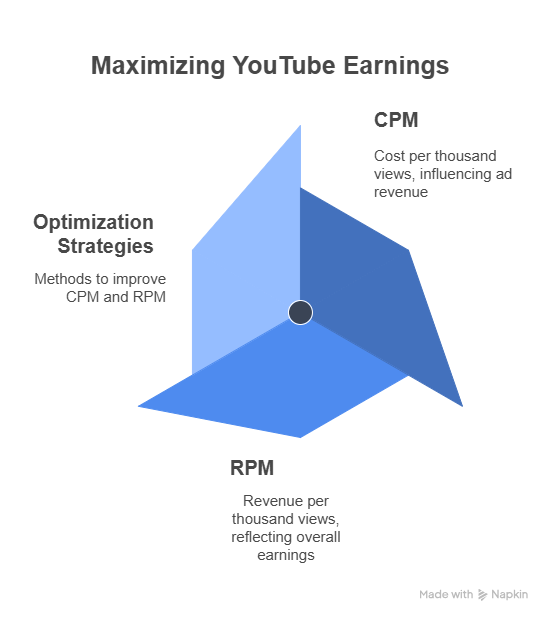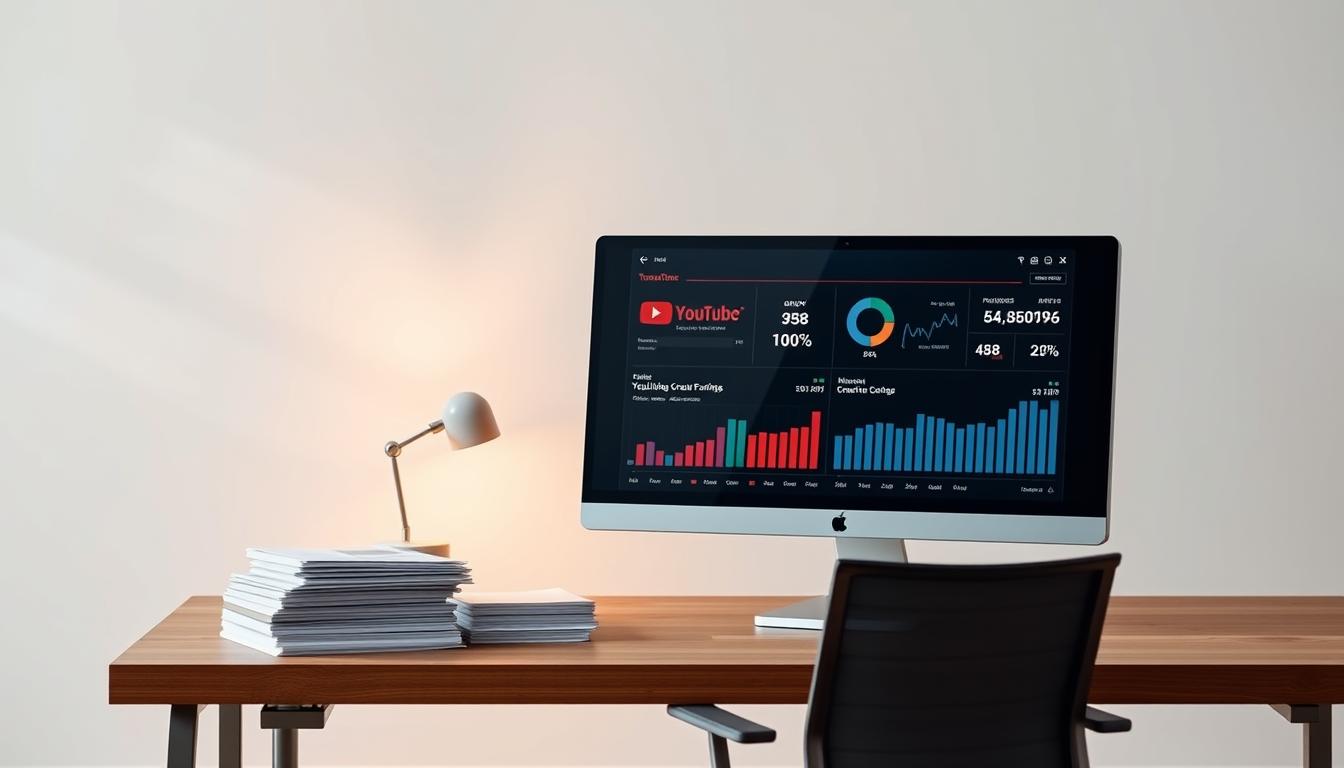Did you know that in 2022, YouTube creators earned over $10 billion in ad revenue? With such a vast amount of money at stake, understanding how YouTube pays its creators is crucial for those looking to monetize their content.
For creators on YouTube, grasping the nuances of monetization is key to maximizing their earnings potential. Two critical metrics that can significantly impact a creator’s income are often discussed but not always clearly understood: CPM and RPM.
Understanding the difference between these two metrics is essential for creators aiming to boost their revenue on the platform. As we dive into the world of YouTube monetization, we’ll explore what CPM and RPM mean and how they affect your earnings.
Understanding YouTube Monetization Basics
The key to unlocking YouTube’s financial potential lies in understanding its monetization fundamentals. YouTube’s vast and complex ecosystem offers creators numerous opportunities to earn money, but it requires a grasp of how the platform’s payment system works.
How YouTube’s Payment System Works
YouTube’s payment system is primarily based on ad revenue. Creators earn money from ads displayed before, during, and after their videos. The platform uses a complex algorithm to determine ad placement, taking into account factors like viewer engagement, video content, and audience demographics. Advertisers pay YouTube for ad views or clicks, and a portion of this revenue is then distributed to content creators.
Key Metrics That Determine Creator Earnings
Several key metrics determine creator earnings on YouTube, including CPM (Cost Per Mille) and RPM (Revenue Per Mille). CPM refers to the cost advertisers pay for 1,000 ad impressions, while RPM is the revenue creators earn per 1,000 views. Understanding these metrics is crucial for creators to optimize their content and maximize earnings.
CPM vs RPM YouTube Earnings: What’s the Difference?
Understanding the nuances between CPM and RPM is crucial for YouTube creators to maximize their earnings. These two metrics, while related, provide different insights into a creator’s revenue.
What is CPM?
CPM, or Cost Per Mille, refers to the amount advertisers pay for every 1,000 views of their ads. It’s a key metric for YouTube creators as it directly affects their earnings. Higher CPM rates mean higher earnings for creators. The CPM rate varies based on factors like niche, audience location, and ad demand.
What is RPM?
RPM, or Revenue Per Mille, represents the estimated revenue a creator earns per 1,000 views. Unlike CPM, RPM takes into account YouTube’s revenue share, providing a more accurate picture of a creator’s earnings. RPM gives creators a clearer understanding of their actual take-home pay. It’s an essential metric for understanding the effectiveness of their monetization strategies.
Why RPM Is Usually Lower Than CPM
RPM is typically lower than CPM because it factors in YouTube’s 45% cut of the ad revenue. This means that for every dollar earned, YouTube takes 45 cents, leaving the creator with 55 cents. As a result, RPM is usually lower than CPM, reflecting the creator’s actual earnings after YouTube’s share.
Key differences between CPM and RPM include:
- CPM is the gross revenue per 1,000 views, while RPM is the net revenue after YouTube’s cut.
- CPM varies with ad demand and niche, whereas RPM is directly tied to the creator’s earnings.
Maximizing Your YouTube Revenue Metrics
To maximize your YouTube earnings, it’s crucial to understand the key revenue metrics and how to optimize them. YouTube’s payment system is based on various factors, including CPM (Cost Per Mille) and RPM (Revenue Per Mille). By focusing on these metrics, you can increase your earnings and grow your channel.
Strategies to Improve Your CPM
Improving your CPM involves creating high-quality, engaging content that attracts advertisers. Here are some strategies to boost your CPM:
- Target high-paying niches: Focus on topics that are in high demand by advertisers.
- Use relevant keywords: Ensure your video titles, descriptions, and tags include relevant keywords.
- Enhance viewer engagement: Create content that encourages viewers to like, comment, and subscribe.
Tactics to Boost Your RPM
Boosting your RPM requires a combination of strategies that increase your overall revenue. Here are some tactics to consider:
- Optimize your video titles and thumbnails to improve click-through rates.
- Increase your watch time by creating engaging, high-quality content.
- Use YouTube’s monetization features, such as Super Chat and Memberships.

Using YouTube Analytics to Track Performance
YouTube Analytics is a powerful tool for tracking your channel’s performance. By analyzing your data, you can identify areas for improvement and adjust your strategies accordingly. Here are some key metrics to track:
- View count and watch time: Monitor your overall view count and watch time to understand your audience’s engagement.
- Earnings and RPM: Track your earnings and RPM to see how your monetization strategies are performing.
- Audience retention: Analyze your audience retention to identify areas where you can improve your content.
Maximizing Your YouTube Earnings: A Content Creator’s Guide
Understanding the nuances of CPM vs RPM is crucial for content creators aiming to maximize their YouTube earnings. By grasping how these metrics impact revenue, creators can develop informed strategies to boost their income.
A thorough content creator revenue analysis reveals that optimizing video content for higher CPM and RPM can significantly enhance earnings. By leveraging YouTube Analytics and adjusting their content strategy accordingly, creators can improve their ad revenue and achieve their financial goals.
As the digital landscape continues to evolve, staying up-to-date on the latest YouTube monetization trends and best practices is essential for creators seeking to succeed. By applying the insights gained from this analysis, content creators can refine their approach and maximize their YouTube revenue.
FAQ
What is the main difference between CPM and RPM on YouTube?
CPM (Cost Per Mille) refers to the cost an advertiser pays for every 1,000 ad impressions, while RPM (Revenue Per Mille) is the estimated revenue a creator earns for every 1,000 views on their YouTube videos, taking into account factors like ad engagement and viewer demographics.
How does YouTube’s payment system work for creators?
YouTube’s payment system is based on the ads displayed on creators’ videos. Creators earn money from these ads through Google AdSense, with the amount earned depending on factors like ad revenue, viewer engagement, and the niche or topic of their content.
What are the key metrics that determine creator earnings on YouTube?
Key metrics include CPM, RPM, click-through rate (CTR), and average view duration. Understanding these metrics helps creators optimize their content and monetization strategies to maximize their earnings.
Why is RPM usually lower than CPM?
RPM is usually lower than CPM because RPM takes into account the revenue share between YouTube and the creator, as well as other factors like ad blockers and viewer engagement. This means that RPM is a more realistic representation of a creator’s actual earnings.
How can creators improve their CPM on YouTube?
Creators can improve their CPM by producing high-quality, engaging content that attracts high-paying advertisers, using relevant keywords, and promoting their videos to increase views and engagement.
What strategies can help boost RPM on YouTube?
To boost RPM, creators can focus on increasing their video’s watch time, improving engagement through comments and likes, and using YouTube Analytics to track their performance and adjust their strategies accordingly.
How does YouTube Analytics help creators track their performance?
YouTube Analytics provides creators with detailed insights into their video performance, including metrics like views, watch time, and earnings. This data helps creators understand their audience, identify areas for improvement, and adjust their content and monetization strategies.
What is the impact of video ad rates on Google AdSense income?
Video ad rates directly impact Google AdSense income, as higher ad rates result in higher earnings for creators. Factors like ad demand, viewer demographics, and content niche influence ad rates, making it essential for creators to understand these dynamics to maximize their earnings.

